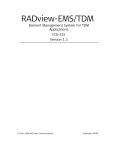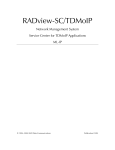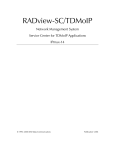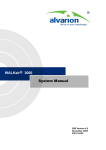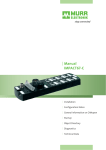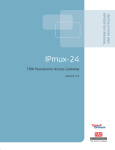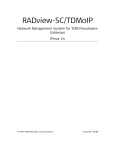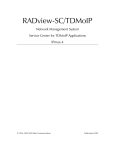Download RADview-EMS - RAD Data Communications
Transcript
RADview-EMS Element Management System RIC-LC © 1994–2013 RAD Data Communications 288-202-01/13 Contents Chapter 1. Introduction 1.1 1.2 RIC-LC Overview ................................................................................................................... 1-1 RADview-EMS RIC-LC Overview ............................................................................................. 1-1 Overview of the RADview FCAPS Model .............................................................................. 1-2 RIC-LC Management Tasks ................................................................................................. 1-2 Chapter 2. Installation and Operation 2.1 2.2 2.3 2.4 2.5 Network Management Options ............................................................................................. 2-1 Pre-Configuring RIC-LC for Network Management ................................................................ 2-2 Connecting a Terminal to the Control Port ......................................................................... 2-2 Configuring Host Parameters ............................................................................................. 2-2 Configuring Management Access........................................................................................ 2-3 Adding a Network Management Station (NMS) .................................................................. 2-3 Configuring the SNMP Communities ................................................................................... 2-4 Connecting RIC-LC to Network Management Stations ........................................................... 2-5 Launching RADview-EMS RIC-LC ............................................................................................ 2-5 Using the Graphical User Interface (GUI) .............................................................................. 2-7 RIC-LC Shelf View Window .................................................................................................. 2-7 Title Bar ........................................................................................................................ 2-7 Menu Bar ...................................................................................................................... 2-7 Toolbar ......................................................................................................................... 2-8 Status Bar ..................................................................................................................... 2-8 RADview RIC-LC Menu Maps ............................................................................................... 2-9 Selecting the Device ........................................................................................................ 2-10 Selecting Ports ................................................................................................................. 2-11 RIC-LC Connectors............................................................................................................ 2-11 RIC-LC LED Indicators ....................................................................................................... 2-12 Chapter 3. Configuration Management 3.1 3.2 3.3 Services ................................................................................................................................ 3-1 Ethernet Management Traffic ............................................................................................ 3-2 Ethernet Traffic Services .................................................................................................... 3-3 Setting the System Parameters ............................................................................................ 3-4 Configuring System Logistics Information .......................................................................... 3-4 Configuring the Host IP Parameters ................................................................................... 3-5 Defining Network Managers ............................................................................................... 3-6 Setting the Operational Parameters ..................................................................................... 3-8 Configuring the System Clocks ........................................................................................... 3-8 Configuring Interfaces at the Physical Level ....................................................................... 3-9 Configuring the E1 Interface ......................................................................................... 3-9 Configuring the Ethernet Interface .............................................................................. 3-11 Configuring the Logical Port ............................................................................................. 3-12 Configuring the Bridge ..................................................................................................... 3-15 Configuring VLAN Membership (Egress) ....................................................................... 3-17 Configuring the Static MAC Table ................................................................................ 3-18 Configuring the Bridge Ports ....................................................................................... 3-20 Configuring the QoS ........................................................................................................ 3-22 Configuring the Traffic Priority .................................................................................... 3-22 RIC-LC Ver. 2.0 i Table of Contents 3.4 User's Manual Configuring the Rate Limitation................................................................................... 3-25 Configuring Fault Propagation .......................................................................................... 3-26 Additional Tasks ................................................................................................................. 3-27 Displaying the System Information .................................................................................. 3-28 Displaying the Logical Port Information ............................................................................ 3-28 Displaying the SFP Information ........................................................................................ 3-30 Setting the Date and Time ............................................................................................... 3-32 Resetting to the Defaults ................................................................................................ 3-34 Resetting RIC-LC .............................................................................................................. 3-35 Chapter 4. Performance Management 4.1 4.2 4.3 4.4 4.5 Introduction ......................................................................................................................... 4-1 Controlling Polling for Statistics Data ................................................................................... 4-1 Displaying GFP Statistics....................................................................................................... 4-2 Displaying E1 Statistics......................................................................................................... 4-3 Displaying Current E1 Interface Statistics ........................................................................... 4-3 Displaying Interval E1 Interface Statistics ........................................................................... 4-5 Displaying Ethernet Interface Statistics ................................................................................ 4-6 Chapter 5. Security Management 5.1 5.2 5.3 5.4 5.5 5.6 RADview-EMS User Security Levels ....................................................................................... 5-1 Monitor .............................................................................................................................. 5-1 Technician ......................................................................................................................... 5-1 Operator and Administrator Levels .................................................................................... 5-1 Adding Users ........................................................................................................................ 5-2 Changing User Names .......................................................................................................... 5-2 Changing Passwords............................................................................................................. 5-3 Removing Users ................................................................................................................... 5-4 Viewing and Setting Access Options ..................................................................................... 5-4 Chapter 6. Fault Management 6.1 6.2 Handling Alarms and Traps ................................................................................................... 6-1 Viewing Device Status ........................................................................................................ 6-1 Displaying Active Alarms .................................................................................................... 6-2 Viewing all Active Alarms ............................................................................................... 6-2 Viewing all System Alarms ............................................................................................. 6-3 Viewing Port Alarms ...................................................................................................... 6-4 Displaying History Log ....................................................................................................... 6-5 Clearing History Log ........................................................................................................... 6-6 Masking Alarms .................................................................................................................. 6-7 Running Diagnostic Tests ..................................................................................................... 6-8 Running Loopbacks ............................................................................................................ 6-8 Running E1 BERT ................................................................................................................ 6-9 Running Virtual Cable Test ............................................................................................... 6-10 Chapter 7. Application Tutorial 7.1 7.2 ii Overview .............................................................................................................................. 7-1 Application ......................................................................................................................... 7-1 Connecting RIC-LC Units to Network Management Stations ............................................... 7-1 Configuration Sequence ..................................................................................................... 7-2 Launching the RIC-LC Shelf View Window ............................................................................. 7-2 RIC-LC Ver. 2.0 User's Manual 7.3 7.4 Table of Contents Configuring the RIC-LC (A) Unit ............................................................................................ 7-3 Configuring E1 Interface at the Physical Level .................................................................... 7-3 Configuring the System Clock ............................................................................................. 7-3 Configuring the Logical Layer ............................................................................................. 7-4 Configuring RIC-LC (B) .......................................................................................................... 7-6 Configuring the Physical Layer ........................................................................................... 7-6 Configuring the System Clock ............................................................................................. 7-6 Configuring the Logical Layer ............................................................................................. 7-7 RIC-LC Ver. 2.0 iii Table of Contents iv User's Manual RIC-LC Ver. 2.0 Chapter 1 Introduction This chapter provides an overview for managing RIC-LC using the RADview-EMS management solution. It introduces the graphical user interface. It is assumed that you are familiar with basic RADview-EMS operations. For more information about basic RADview-EMS operations, refer to the RADview EMS (PC) or (Unix) User's Manual. 1.1 RIC-LC Overview RIC-LC is a Fast Ethernet over E1 converter that provides simple, efficient, and cost-effective Fast Ethernet connectivity over one, four, eight or sixteen bonded E1 circuits. The device enables service providers to supply high-capacity Ethernet services to remote locations and to transparently connect corporate LANs over existing E1 links. RIC-LC supports standard Ethernet over NG-PDH protocols, including GFP ITU-T G.8040, VCAT ITU-T G.7043 and LCAS ITU-T G.7042. These protocols allow service providers to dynamically allocate bandwidth to their customers by merely changing the number of links bonded to the virtual group, without stopping the service. Management is performed locally by a terminal, or remotely via Telnet, Web terminal or SNMP. RIC-LC is supported by two platforms: Note • PC: Standalone and Oracle DB • Unix: Standalone and Oracle DB. • RADview-EMS/WIN can be installed under Windows 7 (64bit) Professional Edition, and Windows 2008 Server R2 (64 bit) Standard Edition operating systems. Windows 7 (32-bit) is not recommended as usable RAM memory is limited to 4 GB. • RADview-EMS/Unix can be installed under SPARC Solaris 10 operating system. 1.2 RADview-EMS RIC-LC Overview This section explains the steps required to get the RADview EMS management system for RIC-LC up and running. It describes the graphical user interface, configurations, security and fault management. Specific tasks possible with RIC-LC are dealt with in the subsequent chapters in this manual. All the configurations RIC-LC Ver. 2.0 RADview-EMS RIC-LC Overview 1-1 Chapter 1 Introduction User's Manual and management support tasks described in this manual can be performed with RADview. The RADview-EMS management system for RIC-LC provides all the tools necessary for monitoring device performance and configuring the parameters for local and remote devices. The RADview-EMS management system for RIC-LC is accessed at two levels: • Device Level • Port Level: Network and user Ethernet ports E1 ports Overview of the RADview FCAPS Model RADview provides a complete management solution for monitoring and controlling the RIC-LC device. The RADview solutions conform to ITU-T Telecommunication Management Network (TMN) recommendations for SNMP management systems, known as the FCAPS model: • Fault management – detects and correlates faults in network devices, isolates faults, and initiates recovery actions. • Configuration management – tracks configuration changes, and configures, installs, and distributes software and configuration files across the network. • Accounting management – collects accounting data and generates network usage reports. • Performance management – continuously monitors network performance (QoS, CoS) and resource allocation. • Security management – controls and restricts access to network resources. RIC-LC Management Tasks Table 1-1 lists the management tasks that are available when you select the entire system. Table 1-1. Mapping of FCAPS Functions to RIC-LC Menu Paths and Manual Sections FCAPS Component Fault Management Function Viewing the active alarms Device Level Port Level Menu Path Section in this Manual Fault > Alarms > All Viewing all Active Alarms Menu Path Section in this Manual (Chapter 6) Viewing the system alarms Fault > Alarms > System Level Viewing all System Alarms (Chapter 6) 1-2 RADview-EMS RIC-LC Overview RIC-LC Ver. 2.0 User's Manual FCAPS Component Chapter 1 Introduction Function Device Level Menu Path Port Level Section in this Manual Viewing the port alarms Viewing the history log Fault > History Log > List Menu Path Section in this Manual Fault > Alarms > Alarms Viewing Port Alarms (Chapter 6) Displaying History Log (Chapter 6) Clearing the history log Fault > History Log > Clear Clearing History Log (Chapter 6) Masking the alarms Fault > Alarm Mask Masking Alarms (Chapter 6) Running E1 loopbacks Running E1 BERT Running Loopbacks Diagnostics > Remote Loop (Chapter 6) Diagnostics > BERT Running E1 BERT (Chapter 6) Running virtual cable test Diagnostics > Virtual Cable Test Running Virtual Cable Test (Chapter 6) Configuration Management Defining management host IP Options > Host Configuring the Host IP Parameters (Chapter 3) Defining network managers Options > Manager List Defining Network Managers (Chapter 3) Configuring system clocks Configuration > System Clocks Configuring the System Clocks (Chapter 3) Configuring E1 interface Configuratio n > Port Parameters Configuring the E1 Interface (Chapter 3) RIC-LC Ver. 2.0 RADview-EMS RIC-LC Overview 1-3 Chapter 1 Introduction FCAPS Component Function User's Manual Device Level Menu Path Port Level Section in this Manual Configuring Ethernet interface Menu Path Section in this Manual Configuratio n > Port Parameters Configuring the Ethernet Interface (Chapter 3) Configuring the Logical Port Configuration> Logical Port Configuring the Logical Port (Chapter 3) Configuring the bridge Configuring the static MAC table Configuration > Bridge > Parameters Configuring the Bridge Configuration > Bridge > MAC Table Configuring the Static MAC Table (Chapter 3) (Chapter 3) Configuring the bridge ports Configuration > Bridge > Bridge Port Configuring the Bridge Ports (Chapter 3) Configuring VLAN membership Configuring Fault Propagation Configuration > Bridge > VLAN Membership (Egress) Configuring VLAN Membership (Egress) Configuration> Fault Propagation Configuring Fault Propagation (Chapter 3) (Cahpter 3) Configuring traffic priority Configuration > QoS > Mapping Mapping Priority to the Traffic Classes (Chapter 3) Configuring rate limitation Configuration > QoS > Rate Limitation Configuratio n > Bridge Port Selecting a Traffic Classification Method (Chapter 3) Configuring the Rate Limitation (Chapter 3) Displaying system information Configuration > System Info Displaying the System Information (Chapter 3) 1-4 RADview-EMS RIC-LC Overview RIC-LC Ver. 2.0 User's Manual FCAPS Component Chapter 1 Introduction Function Displaying logical port information Device Level Port Level Menu Path Section in this Manual Configuration > Logical Port Displaying the Logical Port Information Menu Path Section in this Manual Statistics > Current Displaying Current E1 Interface Statistics (Chapter 3) Defining date and time Configuration > Date & Time Setting the Date and Time (Chapter 3) Resetting to defaults Resetting unit Performance Management Initiating polling sequence Configuration > System Commands > Reset Configuration Resetting to the Defaults Configuration > System Commands > Reboot Agent Resetting RIC-LC Configuration > System Commands > Poll Agent Controlling Polling for Statistics Data (Chapter 3) (Chapter 3) (Chapter 4) Setting Polling Intervals Statistics > Polling Interval Controlling Polling for Statistics Data (Chapter 4) Displaying current E1 statistics (Chapter 4) Displaying interval E1 statistics Statistics > Intervals Displaying Interval E1 Interface Statistics (Chapter 4) Displaying Ethernet statistics Statistics > Interface Statistics Displaying Ethernet Interface Statistics (Chapter 4) RIC-LC Ver. 2.0 RADview-EMS RIC-LC Overview 1-5 Chapter 1 Introduction FCAPS Component Function Displaying GFP Statistics User's Manual Device Level Port Level Menu Path Section in this Manual Statistics> GFP Displaying GFP Statistics Menu Path Section in this Manual (Chapter 4) Security Management Adding Users Adding users (Chapter 5) Changing User Names Changing user names (Chapter 5) Changing Passwords Changing passwords (Chapter 5) Removing Users Removing users (Chapter 5) Defining access methods Options > Access Viewing and Setting Access Options (Chapter 5) 1-6 RADview-EMS RIC-LC Overview RIC-LC Ver. 2.0 Chapter 2 Installation and Operation This chapter explains the installation and operation required to get the RADview-EMS system for RIC-LC up and running. It also describes the RADview-EMS RIC-LC graphic user interface (GUI) and how to select the system and its ports. This chapter discusses the following: • Network Management Options • Pre-Configuring RIC-LC for Network Management • Connecting RIC-LC to Network Management Stations • Launching RADview-EMS RIC-LC • Using the Graphical User Interface (GUI) 2.1 Network Management Options RIC-LC has a local management subsystem that controls the operation of all of its circuits. The subsystem supports various management interfaces, including SNMP management (for example, RADview), Telnet, and local management via an ASCII terminal or a Web browser. RADview management software is typically used to support large networks. Some parameters cannot be changed from within RADview. However, you can use the built-in management menu-driven interface of RIC-LC to configure them. The configuration menus are accessible from a serial connection to the device control port or by using the Telnet protocol via a connection to the Ethernet port. For complete information about managing RIC-LC using the terminal or Telnet, refer to the RIC-LC Installation and Operation Manual. RADview network management software uses SNMP messages to manage RIC-LC via a network management station (NMS). RIC-LC is connected to the management station either on a local LAN or from a remote location, via a PSN connected to one of the unit’s Ethernet ports. RIC-LC Ver. 2.0 Network Management Options 2-1 Chapter 2 Installation and Operation 2.2 User’s Manual Pre-Configuring RIC-LC for Network Management RIC-LC can be managed by a network management station (NMS)located on the LAN that is connected to one of the unit’s Ethernet ports. To remotely administer RIC-LC from a network management station, it is necessary to first configure the basic RIC-LC parameters via an ASCII terminal connected to the RIC-LC control port. The following steps are required: 1. Connect a terminal to the control port. 2. Configure the host parameters. 3. Configure the management access. 4. Add a network manager. 5. Configure the SNMP communities. Connecting a Terminal to the Control Port To configure the basic IP parameters, you must connect an ASCII terminal to the RIC-LC control port and log in. To configure the RIC-LC system parameters: 1. Configure an ASCII terminal as follows: One start bit Eight data bits No parity One stop bit No flow control VT100 emulation. 2. Connect the terminal to the RIC-LC control port. 3. Press <Enter> several times, which allows RIC-LC to detect the data rate. 4. Initiate the control session by entering the administrator user name and password. Configuring Host Parameters You can manage RIC-LC via a network management station connected to one of the unit’s ports. To establish a proper connection, you must configure the Host parameters, such as the Host IP address. To define the Host parameters: 1. From the Main menu, navigate to Configuration > System > Management > Host. The Host menu appears as shown in Figure 2-1. 2-2 Pre-Configuring RIC-LC for Network Management RIC-LC Ver. 2.0 User’s Manual Chapter 2 Installation and Operation RIC-LC System>Management>Host 1. 2. 3. 4. IP Address IP Mask Default gateway Host Tagging (192.168.99.198) (255.255.255.0) (192.168.99.250) (Disable) > Please select item <1 to 4> ESC - prev menu; ! - main menu; CTRL+X - exit <1 Mngr> Figure 2-1. Host Menu 2. Select IP Address and enter the IP address of the IP host. 3. Select IP Mask and enter the host IP subnet mask. 4. Select Default Gateway and enter the default gateway IP address. 5. Select Host Tagging and choose Disable. 6. Select S to save. Configuring Management Access RIC-LC allows you to enable access to the management system via an SNMP application. To configure the management access: • Display the Management Access menu (Configuration > System > Management > Management Access), and set the SNMP access to Enable. RIC-LC System>Management>Management Access 1. 2. 3. 4. 5. User Access Session Timeout(sec)[180-1800] Telnet Access Web Access SNMP Access > (900) (Enable) (Enable) (Enable) > Please select item <1 to 5> ESC - prev menu; ! - main menu; CTRL+X - exit <1 Mngr> Figure 2-2. Management Access Menu Adding a Network Management Station (NMS) To remotely configure RIC-LC, the NMS needs to be listed in the Manager List. NMS configuration defines the IP address of a new network management station. RIC-LC Ver. 2.0 Pre-Configuring RIC-LC for Network Management 2-3 Chapter 2 Installation and Operation User’s Manual The maximum number of network management stations is 10. Each NMS is automatically assigned an index number in the range of 1 to 10. To add a network management station: 1. From the Manager List menu (Configuration > System > Management > Manager List), type F to select the management station to be configured. 2. Select Manager IP Address, and enter the IP address of the management station. 3. Select Manager Trap Mask, and enter Unmask. RIC-LC System>Management>Manager List Manager ID:1 1. Manager IP Address 2. Manager Trap Mask (0.0.0.0) (Unmask) > Please select item <1 to 2> F - Forward ESC - prev menu; ! - main menu; CTRL+X - exit <1 Mngr> Figure 2-3. Manager List Menu Configuring the SNMP Communities RIC-LC allows you to specify the communities in which the RIC-LC management agent accepts SNMP command. To define read, write and trap communities: 1. From the Authentication/Community menu (Configuration > System > Management > Authentication and Community), select SNMP Authentication Failure Trap to enable or disable sending this trap in case of an unauthorized access attempt. 2. Select SNMP Trap Community to enter the name of a community to which RIC-LC sends traps (up to 16 alphanumeric characters, case-sensitive). 3. Select SNMP Read Community to enter the name of a community with read-only authorization (up to 16 alphanumeric characters, case-sensitive). 4. Select SNMP Write Community to enter the name of a community with write authorization (up to 16 alphanumeric characters, case-sensitive). 2-4 Pre-Configuring RIC-LC for Network Management RIC-LC Ver. 2.0 User’s Manual Chapter 2 Installation and Operation RIC-LC System>Management>Authentication and Community 1. 2. 3. 4. SNMP SNMP SNMP SNMP Authentication Failure Trap Trap Community Read Community Write Community (Disable) (SNMP_trap) (public) (private) > Please select item <1 to 4> ESC - prev menu; ! - main menu; CTRL+X - exit <1 Mngr> Figure 2-4. Authentication/Community Menu 2.3 Connecting RIC-LC to Network Management Stations RIC-LC can be managed by a network management station via one of the unit Ethernet ports. The connection can be made from either a local LAN, or a remote location via a PSN. To connect RIC-LC to the network management station: • Connect an Ethernet port to a port of an Ethernet switch or hub serving the network on which the appropriate NMS is attached. 2.4 Launching RADview-EMS RIC-LC Begin using RADview-EMS RIC-LC by launching the respective RIC-LC shelf view. To launch the RIC-LC shelf view: • On the map, select and double-click the RIC-LC icon. The respective RIC-LC shelf view window opens. You can now configure and monitor the unit. RIC-LC Ver. 2.0 Launching RADview-EMS RIC-LC 2-5 Chapter 2 Installation and Operation User’s Manual Figure 2-5. Management Console Figure 2-6. RIC-LC Shelf View Application 2-6 Launching RADview-EMS RIC-LC RIC-LC Ver. 2.0 User’s Manual Chapter 2 Installation and Operation You can open the shelf view through the supporting platforms: • To open the shelf view Zoom window, double-click the desired icon in the EMS Network Elements Tree, or right-click the item in the EMS Network Elements Tree and select Zoom on the object menu. • On a PC (for EMS on standalone – EMS setup with Oracle DB) or a standalone – EMS setup with Oracle DB, you can either double-click the node in the Network Element Browser (provided that the network element default double-click action is set to Shelf View), or you can right-click the node, and on the menu that appears, select Shelf View. 2.5 Using the Graphical User Interface (GUI) From the RIC-LC shelf view window, you can configure and monitor the unit at a system or a port level. RIC-LC Shelf View Window The RADview-EMS RIC-LC shelf view window displays a dynamic graphical representation of the RIC-LC front and back panels. The view shows the front panel, which includes status LEDs for power, diagnostic tests and alarms, and the back panel, which includes AC/DC power connector, E1 and Ethernet ports. The RIC-LC shelf view window contains the following elements: • Title bar • Main menu bar • Toolbar • RIC-LC device (front and back panel views) • Status bar. Title Bar Figure 2-7. Title Bar The title bar (at the top of the shelf view window) displays the name or IP address of the element given on the NMS and indicates whether the device is connected or disconnected. Menu Bar Figure 2-8. Main Menu Bar RIC-LC Ver. 2.0 Using the Graphical User Interface (GUI) 2-7 Chapter 2 Installation and Operation User’s Manual The main menu has drop-down sub-menus. Click a menu to display all the items in that menu. The menu items allow you to perform operations related to the selected elements in the RIC-LC device. The menus are context sensitive; menu items are enabled or disabled as applicable to the selected element. Operations related to specific elements can also be performed using shortcut menus activated by right-clicking the mouse on the selected element. Toolbar Figure 2-9. System Level Toolbar A toolbar below the menu bar allows you to perform specific operations related to the selected elements with a single mouse-click. This toolbar is context sensitive; the icons displayed change according to the RIC-LC element currently selected. Table 2-1. Toolbar Buttons Icon Name Function System Info Displays system info Poll Agent Poll system Reset Configuration Resets device configuration System Level Active Alarm List Displays the system levels alarms All Active Alarm List Displays all active alarms for the device Status Bar Figure 2-10. Status Bar The status bar appears at the bottom of the shelf view window and indicates the current state of the system, as summarized in Table 2-2. Table 2-2. Status Types and Descriptions 2-8 Status Description Working Connection to the device is in progress Waiting Waiting for connection to the device Interrupted Connection to the device failed (time-out) Ready Connection to the device is successful Polling Device polling is in progress. Using the Graphical User Interface (GUI) RIC-LC Ver. 2.0 User’s Manual Chapter 2 Installation and Operation RADview RIC-LC Menu Maps This section illustrates the RV-EMS RIC-LC menus (system and port levels). Configuration Diagnostics Fault System Info Date & Time Alarms All Statistics Options Polling Interval Host GFP Access System Level System Clocks Help User’s Manual About RIC-LC Manager List History Log List Logical Port Bridge Clear Alarm Mask Parameters Bridge Port VLAN Membership (Egress) MAC Table QoS Mapping 802.1p DSCP Port Default Priority Rate Limitation Fault Propagation System Commands Poll Agent Reset Configuration Reboot Agent Figure 2-11. Device Level Menu Map Configuration Port Parameters Fault Diagnostics Alarms All Statistics Options Help BERT Current User’s Manual Remote Loop Intervals About RIC-LC Alarms Figure 2-12. E1 Port Level Menu Map Configuration Port Parameters Diagnostics Fault Alarms Virtual Cable Test Statistics Interface Statistics Options Help User’s Manual All About RIC-LC Alarms Figure 2-13. Ethernet Port Level Menu Map RIC-LC Ver. 2.0 Using the Graphical User Interface (GUI) 2-9 Chapter 2 Installation and Operation User’s Manual Selecting the Device Before you can perform system operations, you must first select the device in the RIC-LC shelf view window. The E1 and Ethernet ports are selectable. All areas that are not ports represent the system, and a border surrounds the panel. The default selection is the device. To select the device: • Click inside the RIC-LC view window. Make sure none of the ports in the window has a border. A blue border surrounds the RIC-LC device, indicating that the whole system is selected. (The main view includes the front and back panels of the device.) Figure 2-14. RIC-LC System Selected in the Shelf View Window The RIC-LC shelf view opens with a specific node name. The NMS discovers the device by recognizing the device’s designated IP address.. 2-10 Using the Graphical User Interface (GUI) RIC-LC Ver. 2.0 User’s Manual Chapter 2 Installation and Operation Selecting Ports Before you can perform port operations, you must first select a port in the RIC-LC shelf view window. To select a port: • In the RIC-LC shelf view window, click a port to select it. A blue border surrounds the port, indicating it is selected. RIC-LC Connectors Table 2-3 lists the RIC-LC ports. Table 2-3. RIC-LC Connectors Name Number of Ports Connector Type Control 1 Mini-USB E1 1, 4, 8, or 16 RJ-45 or BNC Ethernet 4 4 RJ-45 or 2 RJ-45 and 2 SFP Power Supply 1 AC or DC Voltage Operational status for ports is indicated by a color within the port itself, based on polling and trap notifications of interfaces administrational/operational status. The port status is indicated by gray, magenta, or blue. Table 2-4 lists and describes the port status colors. Y Figure 2-15. Port Status Indicators (Blue, Magenta, and Gray) Table 2-4. Port Status Indicators Port Color Description E1 Magenta Errors exist Blue Active test on port Gray No errors exist and no tests are running Magenta Errors exist Blue Active test on port Gray No errors exist and no tests are running Ethernet RIC-LC Ver. 2.0 Using the Graphical User Interface (GUI) 2-11 Chapter 2 Installation and Operation User’s Manual RIC-LC LED Indicators This section lists the device LED indicators and their colors and status descriptions. The RIC-LC shelf view window uses the standard RAD color codes to indicate operational and communication status of the agent, ports, and power supply. Table 2-5. Front Panel LEDs Name Type Function PWR Green LED ON – RIC-LC is powered OFF – RIC-LC is off TEST Yellow LED ON – Test is in progress OFF – No test in progress ALM Red LED ON – Alarms are detected in the current alarm list OFF – No alarm currently detected Table 2-6. Rear Panel LEDs Name Type Function E1 LOC Red LED ON – Synchronization loss is detected (LOS/LOF or AIS in Rx) OFF – The E1 link is synchronized E1 REM Red LED ON – RDI is detected (remote alarm) OFF –No RDI is detected ETH LINK Green LED ON – Ethernet link is OK OFF – The line is not active ETH ACT Yellow LED ON – Data is being transmitted or received on the Ethernet link OFF – The line is no activity 2-12 Using the Graphical User Interface (GUI) RIC-LC Ver. 2.0 Chapter 3 Configuration Management This chapter discusses how to configure the RIC-LC system and operational parameters using RADview-EMS management system. The following topics are covered in the chapter: • • • • Services Ethernet Management Traffic Ethernet Traffic Services Setting the System Parameters Configuring System Logistics Information Configuring the Host IP Parameters Defining Network Managers Setting the Operational Parameters Configuring the System Clocks Configuring Interfaces at the Physical Level Configuring the Logical Port Configuring the Bridge Configuring the QoS Configuring Fault Propagation Additional Tasks Displaying the System Information Displaying the Logical Port Information Displaying the SFP Information Setting the Date and Time Resetting to the Defaults Resetting 3.1 Services This section lists and explains services available for RIC-LC. RIC-LC Ver. 2.0 Services 3-1 Chapter 3 Configuration Management User's Manual Ethernet Management Traffic RIC-LC can be managed using an out-of-band connection via the Ethernet port. In addition, you can create a management path via PSN to manage remote units. The diagram below (Figure 3-1) illustrates the data flow for Ethernet management traffic between the Ethernet or PSN network ports and the host. Table 3-1 illustrates the configuration steps corresponding to the numbers (callouts) in Figure 3-1. Figure 3-1. Ethernet Management Access Traffic Flow Table 3-1. Ethernet Management Traffic Configuration Callout Step Menu Comments 1 Configuring the Host IP Parameters. Options > Host Assigns the IP address, IP mask and default gateway to the RIC-LC unit. 2 Defining a Host VLAN, as described in Configuring the Options > Host Assigns the management VLAN to the host. Host IP Parameters. 3 Configuring the bridge, as described in Configuring the VLAN Tagging must be enabled. Configuration > Bridge Bridge. 4 Configuring the bridge port parameters, as described in Configuration > Bridge > Bridge Port Assigns the host bridge port parameters. You can configure Ingress filtering, Acceptable frame type, Port VID, etc. Configuration > Bridge > Bridge Port Depending on your requirements, you can configure Ingress filtering, Acceptable frame type, Port VID, etc. Configuring the Bridge Ports. 5 Configuring Ethernet ports to the corresponding bridge ports, as described in Configuring the Bridge Ports. 3-2 Services RIC-LC Ver. 2.0 User's Manual Chapter 3 Configuration Management Callout Step Menu Comments 6 Defining logical ports, as described in Configuring the Configuration > Logical Port Logical ports define groups of E1 ports and parameters (GFP). Logical Port. This and the following steps are required to include the remote units in the Management VLAN. 7 Configuring the logical port to the corresponding bridge port, as described in Configuration > Bridge > Bridge Port Configuring the Bridge Ports. 8 Adding the bridge ports associated with the logical ports to the Management VLAN, as described in Configuration > Bridge > VLAN Membership (Egress) Adds the Management VLAN ID to the bridge port. Configuring VLAN Membership (Egress). Ethernet Traffic Services The diagram below illustrates the data flow for Ethernet traffic between the relevant Ethernet or PDH and the PSN network ports. Table 3-2 illustrates the configuration steps corresponding to the numbers (callouts) in Figure 3-2. 2 4 3 Logical Ports E1 Ports 5 ETH packet (ETH over E1 using GFP/VCAT) FE Bridge Ethernet Traffic 1 FE 2 Figure 3-2. Ethernet Traffic Flow Table 3-2. Ethernet Traffic Configuration Callout Step Menu 1 Configuring the bridge, available under Configuring Configuration > Bridge Comments the Bridge. 2 Configuring Ethernet ports to the corresponding bridge ports, available under Configuring the Bridge Ports. RIC-LC Ver. 2.0 Configuration > Bridge > Bridge Port Depending on your requirements, you can configure Ingress filtering, Acceptable frame type, Port VID, etc. Services 3-3 Chapter 3 Configuration Management User's Manual Callout Step Menu Comments 3 Defining logical ports, available under Configuring Configuration > Logical Port Logical ports define groups of E1 ports and parameters (GFP). the Logical Port. 4 Configuring the logical port to the corresponding bridge port, available under Configuration > Bridge > Bridge Port Configuring the Bridge Ports. 5 Adding the bridge ports associated with the logical ports to the Ethernet traffic VLAN, available under Configuration > Bridge > VLAN Membership (Egress) Adds the Ethernet traffic VLAN ID to the bridge port. Configuring VLAN Membership (Egress). 3.2 Setting the System Parameters RADview-EMS allows you to view and modify the system configuration parameters of the managed RIC-LC to prepare it for operation in your specific environment. The required tasks are as follows: • Configuring the system logistics information • Configuring the IP communication parameters (host IP addresses, DHCP) • Defining network managers After completing the general system configuration, make sure to review and set the required RIC-LC security options as detailed in Chapter 5 of this manual. Configuring System Logistics Information The RIC-LC management software allows you to assign a name to the unit and its location, in order to distinguish it from the other devices installed in your system. To view or modify system logistics information: 1. From the shelf view window, click on the unit to select it. 2. Display the System Information menu (Configuration > System Info). 3. Fill in the fields, as described in Table 3-3. 4. Click <Set> to save the changes and update the unit. 3-4 Setting the System Parameters RIC-LC Ver. 2.0 User's Manual Chapter 3 Configuration Management Figure 3-3. System Information Table 3-3. System Information Parameters Parameter Description Description Displays the RIC-LC model, and its hardware and software versions Object ID Displays the formal RIC-LC object identifier Name Used to assign a name to the specific RIC-LC unit (up to 31 characters) Contact Used to enter the name of the person to be contacted in matters pertaining to this RIC-LC unit (up to 31 characters) Location Used to enter a description of the physical location of the RIC-LC unit (up to 31 characters) System Up Time Displays the time elapsed since the RIC-LC has been powered up, or since it has been reset for the last time Number of Interfaces Displays the total number of manageable interfaces present on RIC-LC Configuring the Host IP Parameters The Host dialog box is used to view and modify the IP communication parameters assigned to the RIC-LC management and service hosts. To configure the host IP parameters: 1. From the shelf view window, click on the RIC-LC unit to select it. 2. Display the Host menu (Options > Host). 3. Fill in the fields, as described in Table 3-4. 4. Click <Set> to save the changes and update RIC-LC. RIC-LC Ver. 2.0 Setting the System Parameters 3-5 Chapter 3 Configuration Management User's Manual Figure 3-4. System Parameters Table 3-4. System Parameters Type Parameter Description Values Host IP address IP address of the RIC-LC agent IP address IP Mask IP subnet mask of the RIC-LC agent IP subnet mask compatible with the selected IP address Default Gateway IP address (usually an IP router port) to which the host sends frames when the destination IP address is not within the subnet specified in the Management IP Mask field. IP address This IP address must be within the subnet of the host IP address. The default value, 0.0.0.0, means that no default gateway is defined. VLAN Tagging Controls adding of VLAN tagging to management traffic. Tagged – VLAN tagging is enabled Untagged – VLAN tagging is disabled VLAN ID VLAN ID to be added to all management packets 1–4094 VLAN Priority VLAN priority value to be assigned to all management packets 0–7 Defining Network Managers To remotely configure RIC-LC, the IP address of the NMS must be listed in the Manager List. Up to 10 managers can be defined. To define a network manager: 1. From the shelf view window, click on the RIC-LC unit to select it. 3-6 Setting the System Parameters RIC-LC Ver. 2.0 User's Manual Chapter 3 Configuration Management 2. From the Manager List menu (Options > Manager List), select a manager and click <Change> to set a network manager (see Figure 3-5). 3. Fill in the fields, as described in Table 3-5. 4. Click <Set> to save the changes and update RIC-LC. Figure 3-5. Add Manager Table 3-5. Add Manager Type Parameter Description Values Manager List Manager ID Network manager identification number 1–10 Manager IP Address IP address of the NMS IP address Mask Traps Controls sending alarm traps to the network manager No – Traps are sent Yes – Traps are not sent To delete a network manager: 1. From the Manger List menu (see Figure 3-6), click on a network manager row to select it. 2. Click <Change> to set the Manager IP back to 0.0.0.0. Figure 3-6. Manager List RIC-LC Ver. 2.0 Setting the System Parameters 3-7 Chapter 3 Configuration Management 3.3 User's Manual Setting the Operational Parameters RADview-EMS allows you to view and modify the operational parameters of the managed RIC-LC. The recommended procedure for RIC-LC operation configuration includes the following stages: 1. Configuring the system clock 2. Configuring RIC-LC interfaces at the physical level 3. Configuring the logical port 4. Configuring the RIC-LC bridge Configuring the System Clocks The RIC-LC system timing mechanism ensures a single clock source for all TDM links by providing the master and fallback clocks. If the system clock is locked to one of the RIC-LC TDM links, it is necessary to define clock source (adaptive or loopback) and clock quality. Note The descriptions in this section refer to a device with multi-E1 ports. To configure the system clock: 1. From the shelf view window, click on the RIC-LC unit to select it. 2. Display the System Clocks menu (Configuration > System Clocks). 3. Fill in the fields, as described in Table 3-6. 4. Click <Set> to save the changes and update RIC-LC. Figure 3-7. System Clock 3-8 Setting the Operational Parameters RIC-LC Ver. 2.0 User's Manual Chapter 3 Configuration Management Table 3-6. System Clock Parameters Type Master Clock Parameter Description Values Current Clock The clock that is currently in use Master, Internal Source A master clock source Rx – E1 recovered Rx clock is used as the Tx clock Internal – Clock is provided by internal oscillator Fallback Clock Port Source of the master clock, when the master clock type is adaptive or Rx. Master clock is provided via one of the TDM links or the serial link. An E1 link can be locked to adaptive or loopback clock. E1 1–16 – E1 port 1–16 serves as a source for the master clock Source A fallback clock source None – Fallback clock is not used Rx – E1 recovered Rx clock is used as the Tx clock Port Source of the fallback clock, when the master clock type is adaptive or Rx. Fallback clock is provided via one of the TDM links or the serial link. An E1 link can be locked to adaptive or loopback clock. E1 1–16 – E1 port 1–16 serves as a source for the fallback clock Configuring Interfaces at the Physical Level Before creating PW connections, it is necessary to configure the physical layer parameters of the E1 and Ethernet interfaces. Configuring the E1 Interface The physical layer parameters of the RIC-LC E1 interfaces are configured via the Port Parameters menu. To configure the E1 interface: 1. From the shelf view window, click on an E1 port to select it. 2. Display the Port Parameters menu (Configuration > Port Parameters). 3. Fill in the fields, as described in Table 3-7. 4. RIC-LC Ver. 2.0 Click <Set> to save the changes and update RIC-LC. Setting the Operational Parameters 3-9 Chapter 3 Configuration Management User's Manual Figure 3-8. E1 Port Parameters Table 3-7. E1 Interface Parameters Parameter Description Values Admin. Status Administrative status of the E1 link Up – E1 link is enabled Down – E1 link is disabled Oper. Status Test Status Operational status of the E1 port Up – E1 port is operational Read only Down – E1 port is not operational Status of an E1 diagnostic test ... – No diagnostic test is in progress Read only External Loopback – External loopback is in progress External Bert – External BERT is in progress Interface Type Read only Balanced Unbalanced TX Clock Source Source of the E1 Tx clock Read only Line Type E1 framing mode Line Code System – System clock is used as the Tx clock Read only Framed MF CRC –CAS enabled, CRC-4 function enabled E1 line code HDB3 Read only Rx Sensitivity Maximum attenuation of the receive signal Short haul: -10 dB that can be compensated for by the interface receive path Read only 3-10 Setting the Operational Parameters RIC-LC Ver. 2.0 User's Manual Chapter 3 Configuration Management Configuring the Ethernet Interface The physical layer parameters of the RIC-LC Ethernet interface are configured via the Port Parameters menu. To configure the Ethernet interface: 1. From the shelf view window, click on an Ethernet port to select it. 2. Display the Port Parameters menu (Configuration > Port Parameters). 3. Fill in the fields, as described in Table 3-8. 4. Click <Set> to save the changes and update RIC-LC. Figure 3-9. Ethernet Port Parameters (Physical Layer) Table 3-8. Ethernet Interface Parameters Parameter Description Values Port Ethernet port designation ETH 1-4 – Ethernet port 1-4 Read-only Loop Detection Status Operational status of Loop Detection Enable- Loop detection enabled Disable- Loop detection disabled Admin. Status Administrative status of the FE port Up – FE port is enabled Down – FE port is disabled Oper. Status Operational status of the Ethernet port Up – Port is operational Down – Port is not operational Auto Negotiation Ethernet port autonegotiation functionality Enable – Autonegotiation is enabled Disable – Autonegotiation is disabled RIC-LC Ver. 2.0 Setting the Operational Parameters 3-11 Chapter 3 Configuration Management User's Manual Parameter Description Values Max Capability Advertised Maximum capability to be advertised during the autonegotiation process 10M Half Duplex 10M Full Duplex 100M Half Duplex 100M Full Duplex Speed and Duplex Rate and duplex mode, if the autonegotiation 10M Half Duplex is disabled 10M Full Duplex 100M Half Duplex 100M Full Duplex Flow Control Loop Detection Data flow control method based on Ethernet Pause frames. If the flow control is enabled, RIC-LC received the Pause frames sent by the peer device, slowing its transmission rate. Enable – Flow control is enabled Loop detection on Ethernet Port Enable –Loop detection is enabled Disable – Flow control is disabled Disable –Loop detection is disabled Loop Detection VLAN 1-4094 Configuring the Logical Port Note Descriptions of this section are about the device with multi-E1 ports. You can map multiple E1 ports to a VCAT VCG group, via the Logical Layer menu. To ease configuration effort and save time, the RIC-LC unit is supplied with the logical ports preconfigured (see the table below). A logical port in RIC-LC is either a VCG logical port bound to physical E1 ports, or a GFP logical port that is bound to a VCG logical port. When you create a VCG logical port, RIC-LC automatically creates a GFP logical port that is bound to the VCG logical port, and configures a bridge port bound to the GFP logical port. Therefore, you only need to add/delete VCG logical ports. You do not manually add/delete GFP logical ports. You can only create one VCG logical port. Note A physical port can be bound to only one logical VCG port. Table 3-9. Default Logical Port Settings for E1 Network Interface Logical Port Interface Type Port Name Bound to 1 VCG VCG 1 Physical (E1) ports 1–16 2 GFP GFP 1 Logical port VCG 1 To configure the logical port: 1. From the shelf view window, click on the device to select it. 3-12 Setting the Operational Parameters RIC-LC Ver. 2.0 User's Manual Chapter 3 Configuration Management 2. Display the Logical Ports (Configuration > Logical Port). 3. Configure the logical parameters for each port. Parameter descriptions and possible values are provided in Table 3-10. 4. Click <Set> to save new settings. Figure 3-10. Logical Ports Display RIC-LC Ver. 2.0 Setting the Operational Parameters 3-13 Chapter 3 Configuration Management User's Manual Figure 3-11. Change Logical Port (VCG) Figure 3-12. Change Logical Port (GFP) Table 3-10. Logical Port Parameters Parameter Description Possible Values Logical Port The logical port being configured 1–2 Type Type of interface set for the port. This parameter is read-only VCG GFP Name Free text to assign a name to the logical port VCG 1 GFP 1 Bind to Physical E1 Ports VCAT VCG Logical Port: E1 links that are members of the VCG 1–16 Bind to Logical Port GFP Logical Port: Links to VCG. This parameter is read-only Logical Port 1 3-14 Setting the Operational Parameters RIC-LC Ver. 2.0 User's Manual Chapter 3 Configuration Management Parameter Description Possible Values Admin. Status Administrative state of the logical port Up Down Signal Degradation BER Threshold Signal degrade threshold None, 10E-5, 10E-6, 10E-7, 10E-8, 10E-9 VCAT Header Usage mode of the VCAT byte position. Normal VCAT Header can be set when the VCG logical port binds to one physical port only. Null Data flow control method based on Ethernet Pause frames. If the flow control is enabled, RIC-LC received the Pause frames sent by the peer device, slowing its transmission rate. Enable – Flow control is enabled Max Differential Delay (msec) Maximum allowed delay variation in milliseconds. This parameter is read-only 0-220 Payload FCS GFP payload FCS Enable Flow Control Reserved Disable – Flow control is disabled Disable Loop Detection Looped members are automatically detected and not added to the LCAS when loop detection is enabled. The VCG restarts after enabling or disabling the loop detection Enable Disable Loop Detection VLAN The VLAN that must be excluded from VLAN membership 1–4094 Configuring the Bridge RIC-LC contains an internal bridge connected to the external unit’s ports. The bridge operates in the VLAN-aware and VLAN-unaware modes. Learning and filtering can be enabled or disabled. Static MAC addresses are stored in the MAC table. Each bridge port can be assigned to a VLAN. To configure the bridge parameters: 1. Display the Bridge Parameters menu (Configuration > Bridge > Parameters). 2. Fill in the fields, as described in Table 3-11. 3. RIC-LC Ver. 2.0 Click <Set> to save the changes and update RIC-LC. Setting the Operational Parameters 3-15 Chapter 3 Configuration Management User's Manual Figure 3-13. Bridge Parameters Table 3-11. Bridge Parameters Parameter Description Values VLAN Mode VLAN handling mode of the bridge Aware – The RIC-LC bridge handles VLANs Forwarding mode of the bridge Transparent – No filtering is performed. RIC-LC forwards all received frames. Forwarding Mode Unaware – The RIC-LC bridge does not handle VLANs Filter – RIC-LC filters traffic according the received MAC addresses Aging Time Amount of time a LAN node is 0–3825 sec allowed to be inactive before it is removed from the network. Entering 0 disables the aging. When the aging is disabled, static address entries are never aged or removed from the table. Scheduling Mode Scheduling mode of the bridge Strict Priority – All top priority frames egress until the priority queue is empty. Then the next lower priority queue frames egress, etc. The strict scheme can cause the lower priorities to be starved out preventing them from transmitting any frames, but also ensures that all high priority frames egress the switch as soon as possible. Weighted – All frames are round-robin scheduled according to an 8-4-2-1 weighting for the Traffic Class queue 3, Traffic Class queue 2, Traffic Class queue 1, and Traffic Class queue 0. It prevents the lower priority frames from being starved out with only a slight delay to the higher priority frames. 3-16 Setting the Operational Parameters RIC-LC Ver. 2.0 User's Manual Chapter 3 Configuration Management Configuring VLAN Membership (Egress) Each RIC-LC Ethernet port can be defined as a VLAN member. The ports can also be configured to add, strip or ignore the VLAN tag at the egress. To configure the VLAN membership: 1. From the VLAN Membership (Egress) menu (Configuration > Bridge > VLAN Membership (Egress)), click <Add...>. The Add VLAN Membership (Egress) menu is displayed (Figure 3-14). 2. Fill in the fields, as described in Table 3-12. 3. Click <Set> to save the port VLAN assignments. Figure 3-14. Add VLAN Membership (Egress) Table 3-12. VLAN Membership Parameters Parameter Description Values VLAN ID A VLAN which the bridge ports will be assigned 1–4094 BP1-6 Operation mode of bridge ports 1-6 Tagged – The port adds the tag of the current VLAN to all frames at its egress Untagged – The port strips the tag of the current VLAN to all frames at its egress None – The port does not belong to the current VLAN. If all ports are configured to None for a VLAN, RIC-LC discards all frames with this VLAN ID. To edit the VLAN membership settings: 1. From the VLAN Membership (Egress) menu (Configuration > Bridge > VLAN Membership (Egress)), select a VLAN that you intend to modify and click <Change...>. The Change VLAN Membership (Egress) menu is displayed (Figure 3-15). 2. Fill in the fields, as described in Table 3-12. 3. RIC-LC Ver. 2.0 Click <Set> to save the settings. Setting the Operational Parameters 3-17 Chapter 3 Configuration Management User's Manual Figure 3-15. Change VLAN Membership (Egress) To delete a VLAN: • From the VLAN Membership (Egress) menu, select a VLAN that you intend to delete and click <Remove>. Configuring the Static MAC Table You can add static MAC addresses to the RIC-LC MAC table. When the bridge operates in the VLAN-aware mode, it is possible to assign VLAN ID to a MAC address. To configure the static MAC table: 1. From the MAC Table menu (Configuration > Bridge > MAC Table), click <Add...>. The Add Static Unicast MAC Entry menu is displayed (Figure 3-16). 2. Fill in the fields, as described in Table 3-13. 3. Click <Set> to save the new settings. Figure 3-16. Add Static MAC Address Table 3-13. Static MAC Table Parameters Parameter Description Values VLAN ID A VLAN ID with which frames from the current MAC address are expected to arrive 1–4094 Received Bridge Port The RIC-LC bridge port this MAC address will BP 2-6 be attached to 3-18 Setting the Operational Parameters RIC-LC Ver. 2.0 User's Manual Chapter 3 Configuration Management Parameter Description Values MAC Address A static MAC address To delete a static MAC address: • From the MAC Table menu (Figure 3-17), select a MAC address that you want to delete and click <Remove>. The selected static MAC address is removed from the table. Figure 3-17. Static MAC Address To delete all static MAC addresses: 1. From the MAC Table menu, select <Clear ALL Static>. RIC-LC displays a confirmation message. 2. Click <OK> to confirm the deletion. Static MAC addresses are deleted. To delete all dynamic MAC addresses: 1. From the MAC Table menu, select <Clear Learned>. RIC-LC displays a confirmation message. 2. Click <OK> to confirm the deletion. Dynamic MAC addresses are deleted. RIC-LC Ver. 2.0 Setting the Operational Parameters 3-19 Chapter 3 Configuration Management User's Manual Configuring the Bridge Ports RIC-LC bridge ports support filtering of incoming traffic, accepting all frames of only those, which have VLAN tags. The incoming frames can also be assigned default PVID and priority values. To configure the bridge port: 1. Display the Bridge Port menu (Configuration > Bridge > Bridge Port). Figure 3-18. Bridge Port Menu 2. Select a bridge port and Click <Change> to the modify it. The bridge port parameters are displayed. 3. Fill in the fields, as described in Table 3-14. 4. 3-20 Click <Set> to save the changes and update RIC-LC. Setting the Operational Parameters RIC-LC Ver. 2.0 User's Manual Chapter 3 Configuration Management Figure 3-19. Bridge Port Parameters Table 3-14. Bridge Port Parameters Parameter Description Possible Values Port Bridge port number Bridge Port 1-6 Bind to Number that identifies the bridge port displayed. Bridge port 1 is reserved for the host bridge port. Host Read-only. Eth1-4 GFP Ingress Filtering Specifies whether or not this port is available. Enable Default: Disable Acceptable Frame Type When enabled, the device discards incoming frames for VLANs of which the port is not a member. Default: All Tagged Only When disabled, the port accepts all incoming frames. Port VID Default Priority Tag Tag Only specifies that the device discards untagged frames. All specifies that untagged frames received on this port are accepted and assigned to the PVID for this port. 1–4094 Enable: The priority tag of the original VLAN is copied if a frame arrives with a stacked VLAN tag, otherwise the default priority is used 0–7 Default: 1 Default: 0 Disable: The default priority is used RIC-LC Ver. 2.0 Setting the Operational Parameters 3-21 Chapter 3 Configuration Management User's Manual Parameter Description Possible Values Classification Traffic classification method 802.1p DCSP Port Default Priority Egress Tag Handling Egress Tag Ether Type (Hex) Stacking: Adds the PVID to every frame transmitted from the port (push). Default: None For the received frame, add the TPID to the egress of the port. 0000-ffff Stacking Configuring the QoS RIC-LC supports three methods of traffic classification: • 802.1 priority mapping • DSCP priority mapping • Port default priority mapping Configuring the Traffic Priority RIC-LC provides four priority queues for each bridge port. User traffic can be prioritized according to the VLAN priority, DSCP or per bridge port basis. To define the traffic priority: 1. Select a traffic classification method for a RIC-LC bridge port. 2. Map each value (802.1p tag or DSCP) to a traffic class (0–3). Selecting a Traffic Classification Method A traffic classification method must be selected for each RIC-LC bridge port. To select a traffic classification method: 1. Display the Bridge Port Table menu (Configuration > Bridge Port). 2. Select a bridge port and Click <Change> 3. Fill in the fields, as described in Table 3-15. 4. 3-22 Click <Set> to save the changes and update RIC-LC. Setting the Operational Parameters RIC-LC Ver. 2.0 User's Manual Chapter 3 Configuration Management Figure 3-20. Classification Parameters Table 3-15. Classification Parameters Parameter Description Values Classification Traffic classification 802.1p –Priority is determined according to VLAN method used by the priority current port DSCP – Priority is determined according to the Differentiated Services Codepoint, as specified in RFC 2474 Port Default Priority – Priority is determined by the port default VLAN priority. In the case of the pseudowire and management traffic, it is copied from the service host priority setting. If no service host is configured, the priority is determined by the management host value. Mapping Priority to the Traffic Classes Each traffic classification method must be mapped to one of the four traffic classes (priority queues). To map priority to a traffic class: 1. From the shelf view window, click on the RIC-LC unit to select it. 2. From the Configuration > QoS > Mapping, select a traffic classification method you intend to map: 802.1p, DSCP, or port default priority. The relevant configuration menu is displayed (Figure 3-21, Figure 3-22, Figure 3-23). 3. From the 802.1p or DSCP, click on a traffic class value to select it. 4. Click <Traffic Class> and select a traffic class to be assigned to priority tag value. The configuration values are described in Table 3-16. RIC-LC Ver. 2.0 Setting the Operational Parameters 3-23 Chapter 3 Configuration Management Note User's Manual Port Default Priority tag values are permanently mapped to traffic classes 0–3 as illustrated in Figure 3-23. 5. Click <Set> to save the changes and update RIC-LC. 6. After updating RIC-LC, click <Refresh>. Figure 3-21. 802.1p Mapping Figure 3-22. DSCP Mapping 3-24 Setting the Operational Parameters RIC-LC Ver. 2.0 User's Manual Chapter 3 Configuration Management Figure 3-23. Port Default Priority Mapping Table 3-16. Priority Mapping Parameters (Device Level) Parameter Description 802.1p Mapping Assigns each priority tag, supported by IEEE 802.1p (0–7) to a specific priority queue – Traffic Class 0 (lowest), Traffic Class 1, Traffic Class 2, or Traffic Class 3 (highest) DSCP Assigns each DS codepoint (0–63) to a specific priority queue – Traffic Class 0 (lowest), Traffic Class 1, Traffic Class 2, or Traffic Class 3 (highest) Port Default Priority Displays permanent priority tag assignments. For description of how define a port default priority, see the Configuring the Bridge Ports section above. Configuring the Rate Limitation RIC-LC supports data rate limitation at the egress and ingress of the Ethernet ports. RIC-LC limits the data rate proper, without taking into account Ethernet frame intergaps. To configure rate limitation: 1. From the shelf view window, click on the RIC-LC unit to select it. 2. Display the Rate Limitation menu (Configuration > QoS > Rate Limitation). 3. Fill in the fields, as described in Table 3-17. 4. RIC-LC Ver. 2.0 Click <Set> to save the changes and update RIC-LC. Setting the Operational Parameters 3-25 Chapter 3 Configuration Management User's Manual Figure 3-24. Rate Limitation Table 3-17. Rate Limitation Parameters Parameter Description Values Ingress Rate Limitation Ingress rate of the bridge port Disable, 256K, 512K, 1M, 2M, 3M, 3.5M, 4M, 4.5M, 5M, 8M, 10M, 16M, 20M, 25M, 32M, 40M, 50M, 64M Egress Rate Limitation Egress rate of the bridge port Disable, 256K, 512K, 1M, 2M, 3M, 3.5M, 4M, 4.5M, 5M, 8M, 10M, 16M, 20M, 25M, 40M, 50M, 64M Ingress Rate Limit Type A packet type to which the ingress rate limitation is applied All – The rate limitation is applied to all arriving frames Broadcast/Multicast/DLF –The rate limitation is applied to broadcast, multicast and DLF frames Broadcast/Multicast – The rate limitation is applied to broadcast and multicast frames Broadcast – The rate limitation is applied to broadcast frames Burst Size (Kbps) Burst size of the ingress rate limitation 2-128 Configuring Fault Propagation When fault propagation is on, the fault propagation mechanism notifies local and remote equipment whenever there is a faulty condition between interface groups. This enables routers and switches on both ends of the link to reroute traffic. Eth1 to Eth4 and GFP can be allocated to an interface group. You can configure each interface group to perform a specific action according to the activated fault. To configure fault propagation: 1. From the shelf view window, click on the RIC-LC unit to select it. 2. Display the Fault Propagation menu (Configuration > Fault Propagation), see Figure 3-25 and Table 3-18. 3. In the Failed Group field, select a group interface from the dropdown list. 4. In the Affected Group field, select a group interface from the dropdown list. 5. In the Direction field select Unidirectional or Bidirectional. 6. Click <Set> to save the configuration. 3-26 Setting the Operational Parameters RIC-LC Ver. 2.0 User's Manual Chapter 3 Configuration Management Figure 3-25. Fault Propagation screen Table 3-18. Fault Propagation Parameters Parameter Description Possible Values Group Interfaces (Failed Group) Interface group that initiated the fault alarm Eth1 to Eth4, Group Interfaces (Affected Group) Interface group to which the fault alarm should be forwarded Eth1 to Eth4, Direction The direction of the Alarm Forwarding Default: unidirectional Bidirectional Fault Cause Fault on which the action should be taken Default: Interface Down Action Action taken on affected interface Default: Group Down GFP LP 3.4 GFP LP Additional Tasks This section describes additional operations supported by RADview-EMS RIC-LC, as follows: RIC-LC Ver. 2.0 • Displaying system information • Displaying the interface information • Setting the date and time • Resetting to the defaults • Resetting the unit Additional Tasks 3-27 Chapter 3 Configuration Management User's Manual Displaying the System Information The System Information menu displays information about the current software, hardware and boot revisions of the unit. It also displays the object ID, system uptime, and the number of interfaces present in the device. To display the system information: 1. From the shelf view window, click on the unit to select it. 2. Display the System Information menu (Configuration > System Info), or click on the toolbar. Figure 3-26. System Information (RIC-LC) Displaying the Logical Port Information Note Descriptions of this section are about the device with multi-E1 ports. To display the logical port information: 1. From the shelf view window, click on the RIC-LC unit to select it. 2. Select the Logical Port (Configuration > Logical Port), and click Logical Port Status. 3. Display the Logical Port Status screen, see Table 3-19. 3-28 Additional Tasks RIC-LC Ver. 2.0 User's Manual Chapter 3 Configuration Management Figure 3-27. Logical Port Status Table 3-19. Logical Port Status Parameters Parameter Description Interface Type Logical port type Port Name Name of the logical port Differential Delay Detected differential delay GFP Frame Delineation GFP frame delineation status Loop Detection Status Loop detection status To display the LCAS members status: 1. From the Logical Ports screen (Configuration > Logical Port), click LCAS Members Status. 2. Display the LCAS Members Status screen, see Table 3-20. RIC-LC Ver. 2.0 Additional Tasks 3-29 Chapter 3 Configuration Management User's Manual Figure 3-28. LCAS Members Status Table 3-20. LCAS Members Status Parameters Parameter Description Link PDH link Source Status Status of source side of the link Sink Status Status of sink side of the link Displaying the SFP Information Note If an RIC-LC Fast Ethernet port includes an SFP transceiver, the SFP status information is available via the SFP Info screen. To display the SFP information: 1. From the shelf view window, click on an Ethernet port to select it. 2. Display the SFP Info screen (Configuration > SFP > SFP Info), see Table 3-21. 3-30 Additional Tasks RIC-LC Ver. 2.0 User's Manual Chapter 3 Configuration Management Figure 3-29. SFP Information Table 3-21. SFP Information Parameters Parameter Description Connector Type Connector type of the SFP transceiver Manufacturer Name Name of the SFP manufacturer Manufacturer PN Manufacturer part number Typical Max. Range Typical maximum range of the SFP transceiver Wave Length Operating wavelength of the SFP transceiver Fiber Type Type of the fiber used by the SFP transceiver To display the fiber port optical parameters: 1. From the shelf view window, click on an Ethernet port to select it. 2. Display the Optical Parameters screen (Configuration > SFP > Optical Parameters). Figure 3-30. Optical Parameters RIC-LC Ver. 2.0 Additional Tasks 3-31 Chapter 3 Configuration Management User's Manual 3. Click <History> to display the Fiber Port History Optical Parameters. Figure 3-31. Fiber Port History Optical Parameters Setting the Date and Time You can set the date and time for the RIC-LC internal real-time clock. To configure the date and time: 1. From the shelf view window, click on the RIC-LC unit to select it. 2. Display the System Time Information menu (Configuration > Date & Time). 3. Click on the Date drop-down menu, and select a date. 4. Click <Set> to save the changes and update RIC-LC. or 5. Select the NTP mode: Unicast Client – RIC-LC sends a unicast packet to get date & time from an NTP server according to the Update Interval. Manual – RIC-LC receives date and time from an NTP server when a user manually performs a Send Update Request Once command. 6. Select GMT Region. 7. Select Update Interval. 3-32 Additional Tasks RIC-LC Ver. 2.0 User's Manual Chapter 3 Configuration Management Figure 3-32. Date & Time Information 8. Click on NTP Servers button to display the NTP servers menu. 9. Select an NTP server and click <Change>. The Set NTP Server dialog box is displayed. 10. Set NTP Server Address, Admin Status, and UDP Port. 11. Click <Set> to save the changes. 12. Click <Send Update Request Once> to get the time from NTP server and update RIC-LC. Figure 3-33. NTP Servers Information Figure 3-34. Set NTP Server RIC-LC Ver. 2.0 Additional Tasks 3-33 Chapter 3 Configuration Management User's Manual Table 3-22. Time and Date Parameters Parameter Description Values Date Current system time entered manually or received from an NTP server in the yyyy:mm:dd format Time Current system date entered manually or received from an NTP server in the hh:mm:ss format NTP Mode Controls request timing messages from NTP server on certain interval or manual request Unicast Client, Manual GMT Region Defines offset of NTP or RTC from UTC in hours GMT -12 to +13 Update Interval(sec) Defines time between two consecutive NTP requests when NTP Mode is Unicast Client 15–3600 NTP Servers Configures unicast NTP server(s) IP Adress Configures unicast NTP server IP IP adress Admin Status Administrative status of the NTP server. IPmux-2L sends time/date requests to an enabled NTP server. Enable – NTP Server is enabled Disable – NTP Server is disabled UDP Port Source UDP port of NTP packets sent to the configured server 1–65535 Resetting to the Defaults You can reset RIC-LC to its default settings. In addition, you can reset a local RIC-LC without affecting its management parameters (host IP address, mask and default gateway, defined network managers, and management access methods). To reset RIC-LC to the default settings: 1. From the shelf view window, click on the RIC-LC unit to select it. 2. Select Configuration > System Commands > Reset Configuration or click on the toolbar. A confirmation message appears. Figure 3-35. Confirmation Message for Resetting to Defaults 3. Click <OK> to confirm the reset. 3-34 Additional Tasks RIC-LC Ver. 2.0 User's Manual Chapter 3 Configuration Management Resetting RIC-LC You can perform an overall reset of RIC-LC. The reset does not affect the unit configuration. To reset RIC-LC: 1. From the shelf view window, click on the RIC-LC unit to select it. 2. Select Configuration > System Commands > Reboot Agent. A confirmation message appears. Figure 3-36. Confirmation Message for Unit Reset 3. Click <OK> to confirm the reset. RIC-LC Ver. 2.0 Additional Tasks 3-35 Chapter 3 Configuration Management 3-36 Additional Tasks User's Manual RIC-LC Ver. 2.0 Chapter 4 Performance Management 4.1 Introduction This chapter explains how to monitor the RIC-LC performance and to collect statistics of performance data. The tasks presented in this chapter include: • Controlling Polling for Statistics Data • Displaying GFP Statistics • Displaying E1 Statistics • Displaying Ethernet Interface Statistics 4.2 Controlling Polling for Statistics Data The polling interval determines the intervals at which the RADview-EMS polls the managed RIC-LC for performance monitoring data. This enables refreshing of the displayed statistics at intervals appropriate to your specific requirements. Selecting a smaller polling interval increases the polling frequency, and thus increases the management traffic load and the size of the statistics files stored on the station disk. Changing the polling interval immediately modifies the rate of collection of all the statistics, for all the ports, but does not affect data collected for previous intervals. To control the polling for statistics data: 1. From the shelf view window, click on the RIC-LC unit to select it. 2. Select Statistics > Polling Interval. Figure 4-1. Polling Interval Dialog Box RIC-LC Ver. 2.0 Controlling Polling for Statistics Data 4-1 Chapter 4 Performance Management User's Manual 3. To select the polling interval, use the arrows on the Polling Interval box, or type the desired value. The polling interval can be defined in 5-second increments, in the range of 5 to 60 seconds. The default value is 10 seconds. To initiate polling sequence: 1. From the shelf view window, click on the RIC-LC unit to select it. 2. Select Configuration > System Commands > Poll Agent or click toolbar. on the RADview-EMS polls RIC-LC. 4.3 Displaying GFP Statistics You can display the statistics for the GFP logical ports. To display GFP statistics: 1. From the shelf view window, click on the RIC-LC unit to select it. 2. Select Statistics> GFP. The logical layer statistics are displayed. See Table 4-1 for details. 3. To update the display, click <Poll>. 4. Click Reset Counters to reset the counters. 5. When done, click <Close>. 4-2 Displaying GFP Statistics RIC-LC Ver. 2.0 User's Manual Chapter 4 Performance Management Figure 4-2. Logical Layer Statistics (GFP) Table 4-1. Logical Layer Statistics Parameter Description RX Correct Frames Total number of frames received RX Error Frames Total number of FCS error, oversize or undersize frames received TX Frames Total number of frames transmitted 4.4 Displaying E1 Statistics RADview-EMS can display both current and interval E1 statistics. The statistics are displayed in both table and graph formats. This information is useful for assessing quality of service, for network troubleshooting, and for planning purposes. Displaying Current E1 Interface Statistics The current E1 statistics are displayed for the current 15-minute interval. RIC-LC Ver. 2.0 Displaying E1 Statistics 4-3 Chapter 4 Performance Management User's Manual To display current E1 statistics: 1. From the shelf view window, click on an E1 port to select it. 2. Display the Port Current Statistics screen (Statistics > Current), see Table 4-2. 3. To update the display, click <Poll>. 4. When done, click <Close>. Note The display is automatically updated after each polling. The time remaining until the next polling is indicated at the lower right-hand corner of the display. Figure 4-3. E1 Port Current Statistics Table 4-2. Current E1 Port Statistics Parameters Parameter Description Port The number of the selected port Port Type Port type Time Elapsed (sec) The elapsed time (in seconds) since the beginning of the current interval, in seconds. The range is 1 to 900 seconds ES Number of errored seconds SES Number of severely errored seconds 4-4 Displaying E1 Statistics RIC-LC Ver. 2.0 User's Manual Chapter 4 Performance Management Parameter Description UAS Number of unavailable seconds BES Number of burstly errored seconds Displaying Interval E1 Interface Statistics The interval E1 statistics are displayed for the last 24 hours (96 15-minute intervals). To display interval E1 statistics: 1. From the shelf view window, click on an E1 port to select it. 2. Display the Port Intervals Statistics screen (Statistics > Intervals). 3. When done, click <Close>. The parameters displayed on the Port Intervals Statistics menu are similar to those for the current interval (described in Table 4-2) of the selected port, except for the following additional parameters: RIC-LC Ver. 2.0 • Number of Intervals – displays the number of intervals (up to 96) for which performance monitoring statistics can be displayed • Inv No. – displays the 15-minute interval number • From (hh:mm) – displays the start time of the 15-minute interval • To (hh:mm) – displays the end time of the 15-minute interval. Displaying E1 Statistics 4-5 Chapter 4 Performance Management User's Manual Figure 4-4. E1 Port Interval Statistics 4.5 Displaying Ethernet Interface Statistics The Ethernet Interface Statistics command enables you to view statistics for the selected Ethernet port. The aggregate statistics for the port are displayed in a dialog box. This information is useful for assessing quality of service, for network troubleshooting and planning purposes. To display Ethernet interface statistics: 1. From the shelf view window, click on an Ethernet port to select it. 2. Display the Interface Statistics screen (Statistics > Interface Statistics), see Table 4-3. 3. To update the display, click <Poll>. 4. Click Reset Counters to reset the counters. 5. When done, click <Close>. Note 4-6 The display is automatically updated after each polling. The time remaining until the next polling is indicated at the lower right-hand corner of the display. Displaying Ethernet Interface Statistics RIC-LC Ver. 2.0 User's Manual Chapter 4 Performance Management Figure 4-5. Ethernet Interface Statistics Table 4-3. Ethernet Interface Statistics Parameters Type Received from Ethernet Transmitted to Ethernet RIC-LC Ver. 2.0 Parameter Description Port The number of the selected port Unicasts Frames Number of correct unicast frames received Broadcasts Frames Number of correct broadcast frames received MulticastS Frames Number of correct multicast frames received Good Octets Total number of octets (bytes) received. When a valid connection is established, the number should increase steadily. Oversize Frames Number of frames exceeding the maximum allowed frame size 2048 octets, but are otherwise valid Ethernet frames (good CRC) Undersize Frames Number of frames received that were less than 64 octets long, but are otherwise valid Ethernet frames (good CRC) Fragments Number of frames that are shorter than 64 bytes and have an invalid CRC Jabber Number of frames that are too long and have an invalid CRC FCS Errors Number of FCS error Unicasts Frames Number of correct unicast frames transmitted Broadcasts Frames Number of correct broadcast frames transmitted Multicasts Frames Number of correct multicast frames transmitted Displaying Ethernet Interface Statistics 4-7 Chapter 4 Performance Management Type 4-8 User's Manual Parameter Description Good Octets Number of octets successfully transmitted. When a valid connection is established the number should increase steadily. Collision Number of successfully transmitted frames whose transmission is inhibited by a collision event Displaying Ethernet Interface Statistics RIC-LC Ver. 2.0 Chapter 5 Security Management 5.1 RADview-EMS User Security Levels User management is a basic security feature of RADview-EMS. The user security levels are managed by RADview-EMS Security Console. The EMS Security Console is a tool that enables users with security administrative rights to do the following: • View and manage the EMS Security profiles in a graphical interface • Create and edit security profiles • Manage user accounts. For details, refer to the RADview-EMS User’s Manual. The followingsections present an overview of the four user security levels: Monitor, Technician, Operator, and Administrator. Monitor A user at the Monitor level can monitor all types of information related to the managed device, but cannot perform any action that causes a change in the device. This means that any action requiring the use of Set, Apply, Delete, Change, Add, Remove, and similar operations, either within a dialog box or by selecting a menu option, is prevented in either of following ways: • To view additional information, the Monitor can modify fields in a dialog box, but cannot activate the changes because the Set, Apply, Delete, Change, Add, Remove, and similar operations are blocked. Any attempt to activate a change will be denied, and the Monitor will be notified. • Some dialog boxes do not provide any additional information, but merely allow changes in the system. Since a Monitor cannot use these dialog boxes, they are not displayed at this level. Technician The Technician level is granted all the permissions of the Monitor level, and in addition is allowed to perform port tests. The response to actions beyond the level of Technician permissions are handled in the same manner as for the Monitor level. Operator and Administrator Levels The Operator is granted all the permissions needed to perform any task related to RIC-LC management. RIC-LC Ver. 2.0 RADview-EMS User Security Levels 5-1 Chapter 5 Security Management User's Manual The Administrator has all the Operator permissions, and access to the RADviewEMS User Manager function, which is not accessible by the Operator. 5.2 Adding Users To add a user: 1. From the EMS Security Administrator window, select User > Add... The Add User dialog box is displayed (see Figure 5-1). 2. Enter the User Name and Description. 3. Select Profile (from one of the existing profiles). 4. Enter the user Password. 5. Enter the user password again to Confirm Password. 6. Click <Set>. Figure 5-1. Add User Dialog Box 5.3 Changing User Names To change a user: 1. In the EMS Security Administrator window, select User > Edit... The Edit User dialog box is displayed (see Figure 5-2). 2. If necessary, make changes to User Name, Description, Profile, or Lock. 3. Click <Set>. 5-2 Changing User Names RIC-LC Ver. 2.0 User's Manual Chapter 5 Security Management Note You cannot edit your own User properties. Figure 5-2. Edit User Dialog Box Note • This entry is enabled only when an entry in the Users Table is selected. • When Admin Lock is selected, the user cannot use the system until the Administrator clears Admin Lock. 5.4 Changing Passwords To change a user password: 1. In the EMS Security Administrator window, select User > Edit... The Edit User dialog box is displayed (see Figure 5-2). 2. Click <Change Password>. The Change Password dialog box is displayed (Figure 5-3). 3. Enter the new Password. 4. Enter the new password again to Confirm Password. 5. Click <Set>. RIC-LC Ver. 2.0 Changing Passwords 5-3 Chapter 5 Security Management User's Manual Figure 5-3. Change Password Dialog Box 5.5 Removing Users To remove a user: 1. In the EMS Security Administrator window, select User > Remove. The Confirm User Removal dialog box is displayed (see Figure 5-4). 2. Click <OK>. Figure 5-4. Confirm User Removal Confirmation Box 5.6 Viewing and Setting Access Options RADview-EMS allows you to view and modify the authorizations for management access to an RIC-LC unit by means of Telnet and Web browsers. Access by means of the supervision terminal is always available, and SNMP access cannot be disabled by SNMP commands (not even by commands from the RADview-EMS). To view or modify the Telnet and Web browser access options: 1. From the zoom application window, click on the RIC-LC unit to select it. 2. From the Access menu (Options > Access), and select the desired option: 5-4 Disable – access by Telnet and Web browsers is blocked. This overrides the access rights of any user that may be logged on RIC-LC. Note that activating this selection disconnects the currently logged on users. Enable – access is allowed to any logged user. Viewing and Setting Access Options RIC-LC Ver. 2.0 User's Manual Chapter 5 Security Management Note Managers Only – access by Telnet and Web browsers is allowed only to the management stations configured by means of the Manager List (Options > Manager List). Activating this option may also disconnect currently logged users. 3. Click <Set> to save the new configuration. Figure 5-5. Access Menu RIC-LC Ver. 2.0 Viewing and Setting Access Options 5-5 Chapter 5 Security Management 5-6 Viewing and Setting Access Options User's Manual RIC-LC Ver. 2.0 Chapter 6 Fault Management This chapter provides instructions for performing RIC-LC fault management tasks by means of the RADview-EMS. These tasks include: • Handling Alarms and Traps • Running Diagnostic Tests 6.1 Handling Alarms and Traps RIC-LC continuously monitors critical signals and signal processing functions. Whenever a problem is detected, RIC-LC generates a time-stamped alarm message for the event. The time stamp is provided by an internal real-time clock, which can be synchronized with the management station clock using Configuration> Date & Time. RADview-EMS displays: • The currently active alarms reported by RIC-LC • The log of all RIC-LC alarms that are stored in the alarm buffer Various diagnostic tests can be used to determine the causes of the alarm messages. For continuous monitoring, detected alarms can also be sent automatically as traps to the user-specified managers. (The managers are configured using Options > Manager List.) Viewing Device Status Each level and node icon in the navigation tree and the map area has a status icon that indicates the most severe alarm, as specified in the following table. Table 6-1. Network Element Repository Status Icons- Unix Icon RIC-LC Ver. 2.0 Color Status Green Normal Blue Warning Dark yellow Minor Orange Major Red Critical Handling Alarms and Traps 6-1 Chapter 6 Fault Management User's Manual Icon Color Status Red Disconnected Gray Administrative status is set to down Gray Unknown node type Table 6-2. Network Element Repository Status Icons- PC Icon Color Status Green Normal Blue Warning Dark yellow Minor Orange Major Red Critical Red Disconnected Gray Administrative status is set to down Gray Unknown node type Displaying Active Alarms RV-EMS allows you to view all the currently-active alarms reported by RIC-LC, at both the system and port level. Note This function can be accessed by all RV-EMS users, including users with Monitor or Technician permission. Viewing all Active Alarms To view all active alarms: 1. From the shelf view window, click on the RIC-LC unit to select it. 2. Select Fault> Alarms> All. The All Active Alarms List is displayed (Figure 6-1). 3. If the list is not empty, you have the following options: Print the alarm list: click <Print>. Save the alarm list as a Comma Separated Values file (extension .csv): click <Save to File>. 4. To refresh the list, click <Refresh>. 6-2 Handling Alarms and Traps RIC-LC Ver. 2.0 User's Manual Chapter 6 Fault Management Figure 6-1. All Active Alarm List Table 6-3. All Active Alarm List Parameters Parameter Description Port Port of alarm origin Alarm Code The alarm or event identification code Description Text string that provides a concise description of the alarm condition or event Severity The severity of the alarm: Warning, Event, Minor, Major, Critical Viewing all System Alarms To view system alarms: 1. From the shelf view window, click on the RIC-LC unit to select it. 2. Select Fault > Alarms > System Level. The System Level Active Alarms List is displayed (Figure 6-2). 3. If the list is not empty, you have the following options: RIC-LC Ver. 2.0 Print the alarm list: click <Print>. Handling Alarms and Traps 6-3 Chapter 6 Fault Management User's Manual Save the alarm list as a Comma Separated Values file (extension .csv): click <Save to File>. 4. To refresh the list, click <Refresh>. Figure 6-2. System Level Active Alarm List Viewing Port Alarms To view port alarms: 1. From the shelf view window, click on an RIC-LC E1 or FE port to select it. 2. Select Fault > Alarms > Alarms. The Port Active Alarms List is displayed (Figure 6-3). 3. If the list is not empty, you have the following options: Print the alarm list: click <Print>. Save the alarm list as a Comma Separated Values file (extension .csv): click <Save to File>. 4. To refresh the list, click <Refresh>. 6-4 Handling Alarms and Traps RIC-LC Ver. 2.0 User's Manual Chapter 6 Fault Management Figure 6-3. E1 Port Active Alarm List Displaying History Log The history log records the details of all events. The history log file dialog box displays 256 log entries per page, and the buffer itself can hold up to 2048 log entries. Setting the RIC-LC device to its default configuration or resetting the RIC-LC clears the history log. To display the history log: 1. From the shelf view window, click on the RIC-LC unit to select it. 2. Select Fault > History Log > List. The History Log is displayed (Figure 6-4). 3. If the log is not empty, you have the following options: RIC-LC Ver. 2.0 Print the alarm list: click <Print> Save the alarm list as a Comma Separated Values file (extension .csv): click <Save to File> Handling Alarms and Traps 6-5 Chapter 6 Fault Management User's Manual Display the next page: click <Next> Display alarms starting from a selected number: click <Start From> and enter a starting alarm index number 4. To refresh the list, click <Refresh>. Figure 6-4. Alarm History Log Clearing History Log You can delete all entries from the alarm history log. To clear the history log: 1. From the shelf view window, click on the RIC-LC unit to select it. 2. Select Fault > History Log > Clear. The Clearing Log Buffer confirmation message is displayed. Figure 6-5. Clearing Log Buffer Confirmation Message 3. Click <OK> to confirm the deletion. 6-6 Handling Alarms and Traps RIC-LC Ver. 2.0 User's Manual Chapter 6 Fault Management Masking Alarms RIC-LC system and port alarm traps can be masked. To mask an alarm: 1. From the shelf view window, click on the RIC-LC unit to select it. 2. Select Fault > Alarm Mask. The Alarm Mask menu is displayed (Figure 6-6 and Figure 6-7). 3. From the Alarm Mask menu, define the masking: Level –Level of the alarms to mask (System or Port) Port Type –Type of the port to mask (Ethernet Port, E1 Port, VCG Port, GFP Port) Port – A specific port to mask 4. Click <Filter> to apply your selection. 5. Select the alarms to mask. 6. Click <Apply> to save the changes and update the unit. Figure 6-6. Alarm Mask Menu (System-Level Alarms are Displayed) RIC-LC Ver. 2.0 Handling Alarms and Traps 6-7 Chapter 6 Fault Management User's Manual Figure 6-7. Alarm Mask Menu (Port-Level Alarms are Displayed) 6.2 Running Diagnostic Tests RV-EMS supports diagnostic functions that test RIC-LC for proper operation, and isolate the location of faults. This includes the following tests: • Internal and external loopbacks • Internal and external BERT • Virtual Cable Test Running Loopbacks The unit supports activation of the E1 interface diagnostic loopbacks by externally testing the connection between the E1 port and user E1 equipment. To run a loopback: 1. From the shelf view window, click on an E1 port to select it. 2. From the Remote Loop menu (Diagnostics > Remote Loop), select Enable to run the test or choose Disable to deactivate an active loopback (see Table 62). 3. Click <Set>. Figure 6-8. Diagnostic Loopback (E1 Interface) 6-8 Running Diagnostic Tests RIC-LC Ver. 2.0 User's Manual Chapter 6 Fault Management Table 6-4. Interface Loopback Parameters Parameter Description Values Port Number of the port to be tested E1 1–16 Remote Loop Enables or disables a remote loopback procedure Disable – Loopback is disabled Enable – Loopback is enabled Running E1 BERT RIC-LC includes a built-in internal and external BERT utility to monitor the TDM link quality. The BERT test can be run on separate timeslots. BERT test pattern is also user-selectable. To run E1 BERT: 1. From the shelf view window, click on an E1 port to select it. 2. From the BERT menu (Diagnostics > BERT), configure, activate or deactivate a BERT test (see Table 6-3). 3. The BERT result displays in the current frame. To control the polling interval for the statistics data, click Polling Interval. To activate the test, click Start Test. To deactivate the test, click Stop Test. To clear the Bit Error Count, click Clear Error Bits. To inject a single error into the transmitted test pattern, click Inject Single Error. Figure 6-9. BERT RIC-LC Ver. 2.0 Running Diagnostic Tests 6-9 Chapter 6 Fault Management User's Manual Table 6-5. BERT Test Parameters Parameter Description Values Port Number of the port to be tested E1 1-16 Test Test status of the BERT None – BERT is disabled BERT Sync State Sync status of the BERT Not in Sync In Sync Bit Error Count Total number of error bits Bit Error Seconds Total number of seconds in which errors have been detected BERT Runtime Total time the test is running Pattern A pseudo-random BERT pattern to be used during the test 2E15-1 Running Virtual Cable Test This diagnostic can be used to check the quality of the Tx/Rx cables, connectors and terminations. To run a virtual cable test: 1. From the shelf view window, click on an ETH port to select it. 2. Select Diagnostics > Virtual Cable Test. Figure 6-10. Virtual Cable Test 3. To run the test click Test Command. The test causes a temporary port shutdown. 4. To view the results of the virtual cable test, click Poll Results. 6-10 Running Diagnostic Tests RIC-LC Ver. 2.0 Chapter 7 Application Tutorial This chapter provides detailed instructions for setting up a typical application using RIC-LC. 7.1 Overview Application Figure 7-1 illustrates an application in which one RIC-LC unit provides Ethernet cellular backhauling, working opposite a third-party Ethernet device. Figure 7-1. Ethernet Cellular Backhauling over PDH/SDH This application has the following requirements: • E1 links to the SDH network • Third-party Ethernet device that can work opposite the RIC-LC interfaces. Connecting RIC-LC Units to Network Management Stations RIC-LC can be managed by a network management station (NMS) via the RIC-LC Ethernet ports. The connection can be made from either a local LAN or a remote location, via a PSN. To connect RIC-LC to the network management station: • RIC-LC Ver. 2.0 Connect an Ethernet port to a port of an Ethernet switch or hub serving the network on which the NMS is connected. Overview 7-1 Chapter 7 Application Tutorial User's Manual Configuration Sequence The configuration procedure consists of the following stages: 1. Configuring host IP parameters 2. Configuring physical port parameters 3. Configuring the logical layer Table 7-1. Host IP Parameters Device Host IP IP mask Default Gateway RIC-LC (A) 192.188.10.12 255.255.255.0 192.188.10.1 RIC-LC (B) 192.188.10.13 255.255.255.0 192.188.10.1 7.2 Launching the RIC-LC Shelf View Window Launch the RIC-LC shelf view to gain access to the unit. To launch the RIC-LC shelf view: • On the map, select and double-click the RIC-LC icon. The RIC-LC shelf view window opens. You can now configure and monitor the unit. Figure 7-2. RIC-LC (A) Shelf view 7-2 Launching the RIC-LC Shelf View Window RIC-LC Ver. 2.0 User's Manual Chapter 7 Application Tutorial 7.3 Configuring the RIC-LC (A) Unit This section explains how to configure the central RIC-LC (A) unit. To configure RIC-LC (A), first configure the IP parameters and the manager’s list; refer to Chapter 2, Configuring Host Parameters and Configuring Management Access. Configuring E1 Interface at the Physical Level To configure the E1 physical layer: 1. From the shelf view window, click on an E1 port to select it. 2. Display the Port Parameters menu (Configuration > Port Parameters). 3. Set the admin status to Up. 4. Click <Set> to save the changes and update RIC-LC (A). Figure 7-3. Configuring E1 Interface for RIC-LC (A) Configuring the System Clock The configuration procedure for system clock parameters is similar for the two RIC-LC units. To configure the system clock source for RIC-LC (A): 1. From the shelf view window, click on the RIC-LC (A) unit to select it. 2. Display the System Clocks menu (Configuration > System Clocks). 3. Set the master clock source to Internal. 4. RIC-LC Ver. 2.0 Click <Set> to save the changes and update RIC-LC (A). Configuring the RIC-LC (A) Unit 7-3 Chapter 7 Application Tutorial User's Manual Figure 7-4. Defining System Clock for RIC-LC Configuring the Logical Layer For the unit, you can use the default logical layer configuration (logical port VCG 1 bound to E1 ports 1–16). To configure the logical layer: 1. From the shelf view window, click on the RIC-LC (A) unit to select it. 2. Display the Logical Ports menu (Configuration > Logical port). 3. To change the default configuration, select the desired logical port and click Change. 7-4 Configuring the RIC-LC (A) Unit RIC-LC Ver. 2.0 User's Manual Chapter 7 Application Tutorial Figure 7-5. Logical ports Parameters 4. Make the desired changes and click Set to save them. Figure 7-6. Configuring the Logical Ports RIC-LC Ver. 2.0 Configuring the RIC-LC (A) Unit 7-5 Chapter 7 Application Tutorial 7.4 User's Manual Configuring RIC-LC (B) The configuration procedure of the B unit is similar, except for defining different management and service host IP addresses. To configure RIC-LC (B) on the device, first configure the IP parameters and the manager’s list; refer to Chapter 2, Configuring Host Parameters and Configuring Management Access. Configuring the Physical Layer To configure the E1 physical layer: 1. From the shelf view window, click on an E1 port to select it. 2. Display the Port Parameters menu (Configuration > Port Parameters). 3. Set the Admin Status to Up. 4. Click <Set> to save the changes and update RIC-LC (B). Figure 7-7. Configuring E1 Interface for RIC-LC (A) Configuring the System Clock The B unit is configured to use the system internal clock as the transmit clock source for their E1 links. To configure the system clock: 1. From the shelf view window, click on the RIC-LC (B) unit to select it. 2. Display the System Clocks menu (Configuration > System Clocks). 3. Set the master clock source to Rx. 4. 7-6 Specify the port to be used. Configuring RIC-LC (B) RIC-LC Ver. 2.0 User's Manual Chapter 7 Application Tutorial 5. Select Set. Figure 7-8. Defining System Clock for RIC-LC (B) Configuring the Logical Layer For the unit, you can use the default logical layer configuration (logical port VCG 1 bound to E1 ports 1–16). To configure the logical layer: 1. From the shelf view window, click on the RIC-LC (A) unit to select it. 2. Display the Logical Ports menu (Configuration > Logical port). 3. To change the default configuration, select the logical port, and click Change. RIC-LC Ver. 2.0 Configuring RIC-LC (B) 7-7 Chapter 7 Application Tutorial User's Manual Figure 7-9. Logical ports Parameters 4. Modify the settings as needed, and click Set to save them. Figure 7-10. Configuring the Logical Ports 7-8 Configuring RIC-LC (B) RIC-LC Ver. 2.0




























































































